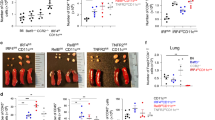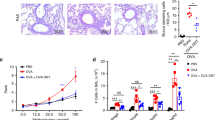Abstract
Respiratory exposure to allergen induces T cell tolerance and protection against the development of airway hyperreactivity and asthma. However, the specific mechanisms by which tolerance is induced by respiratory allergen are not clear. We report here that pulmonary dendritic cells (DCs) from mice exposed to respiratory antigen transiently produced interleukin 10 (IL-10). These phenotypically mature pulmonary DCs, which were B-7hi as well as producing IL-10, stimulated the development of CD4+ T regulatory 1–like cells that also produced high amounts of IL-10. In addition, adoptive transfer of pulmonary DCs from IL-10+/+, but not IL-10−/−, mice exposed to respiratory antigen induced antigen-specific unresponsiveness in recipient mice. These studies show that IL-10 production by DCs is critical for the induction of tolerance, and that phenotypically mature pulmonary DCs mediate tolerance induced by respiratory exposure to antigen.
This is a preview of subscription content, access via your institution
Access options
Subscribe to this journal
Receive 12 print issues and online access
$209.00 per year
only $17.42 per issue
Buy this article
- Purchase on Springer Link
- Instant access to full article PDF
Prices may be subject to local taxes which are calculated during checkout






Similar content being viewed by others
References
McMenamin, C., Schon-Hegrad, M., Oliver, J., Girn, B. & Holt, P. G. Regulation of IgE responses to inhaled antigens: cellular mechanisms underlying allergic sensitization versus tolerance induction. Int. Arch. Allergy Appl. Immunol. 94, 78–82 (1991).
McMenamin, C. & Holt, P. G. The natural immune response to inhaled soluble protein antigens involves major histocompatibility complex (MHC) class I-restricted CD8+ T cell-mediated but MHC class II-restricted CD4+ T cell-dependent immune deviation resulting in selective suppression of immunoglobulin E production. J. Exp. Med. 178, 889–899 (1993).
Melamed, D. & Friedman, A. Direct evidence for anergy in T lymphocytes tolerized by oral administration of ovalbumin. Eur. J. Immunol. 23, 935–942 (1993).
Chen, Y. et al. Peripheral deletion of antigen-reactive T cells in oral tolerance. Nature 376, 177–180 (1995).
Holt, P. G., Schon-Hegrad, M. A. & Oliver, J. MHC class II antigen-bearing dendritic cells in pulmonary tissues of the rat. Regulation of antigen presentation activity by endogenous macrophage populations. J. Exp. Med. 167, 262–274 (1988).
Holt, P. G., Schon-Hegrad, M. A., Phillips, M. J. & McMenamin, P. G. Ia-positive dendritic cells form a tightly meshed network within the human airway epithelium. Clin. Exp. Allergy 19, 597–601 (1989).
Pollard, A. M. & Lipscomb, M. F. Characterization of murine lung dendritic cells: similarities to Langerhans cells and thymic dendritic cells. J. Exp. Med. 172, 159–167 (1990).
Lambrecht, B. N. et al. Myeloid dendritic cells induce Th2 responses to inhaled antigen, leading to eosinophilic airway inflammation. J. Clin. Invest. 106, 551–559 (2000).
Kearney, E. R., Pape, K. A., Loh, D. Y. & Jenkins, M. K. Visualization of peptide-specific T cell immunity and peripheral tolerance induction in vivo. Immunity 1, 327–239 (1994).
Tsitoura, D. C., Blumenthal, R. L., Berry, G., Dekruyff, R. H. & Umetsu, D. T. Mechanisms preventing allergen-induced airways hyperreactivity: role of tolerance and immune deviation. J. Allergy Clin. Immunol. 106, 239–246 (2000).
Tsitoura, D. C., DeKruyff, R. H., Lamb, J. R. & Umetsu, D. T. Intranasal exposure to protein antigen induces immunological tolerance mediated by functionally disabled CD4+ T cells. J. Immunol. 163, 2592–2600 (1999).
Iwasaki, A. & Kelsall, B. L. Freshly isolated Peyer's patch, but not spleen, dendritic cells produce interleukin 10 and induce the differentiation of T helper type 2 cells. J. Exp. Med. 190, 229–239 (1999).
Wu, L., Li, C. L. & Shortman, K. Thymic dendritic cell precursors: relationship to the T lymphocyte lineage and phenotype of the dendritic cell progeny. J. Exp. Med. 184, 903–911 (1996).
Vremec, D. & Shortman, K. Dendritic cell subtypes in mouse lymphoid organs: cross-correlation of surface markers, changes with incubation, and differences among thymus, spleen, and lymph nodes. J. Immunol. 159, 565–573 (1997).
Pulendran, B. et al. Developmental pathways of dendritic cells in vivo: distinct function, phenotype, and localization of dendritic cell subsets in FLT3 ligand- treated mice. J. Immunol. 159, 2222–2231 (1997).
Stumbles, P. A. et al. Resting respiratory tract dendritic cells preferentially stimulate T helper cell type 2 (Th2) responses and require obligatory cytokine signals for induction of Th1 immunity. J. Exp. Med. 188, 2019–2031 (1998).
Sander, B., Andersson, J. & Andersson, U. Assessment of cytokines by immunofluorescence and the paraformaldehyde-saponin procedure. Immunol. Rev. 119, 65–93 (1991).
Groux, H. et al. A CD4+ T-cell subset inhibits antigen-specific T-cell responses and prevents colitis. Nature 389, 737–742 (1997).
Lambrecht, B. N., Pauwels, R. A. & Fazekas De St Groth, B. Induction of rapid T cell activation, division, and recirculation by intratracheal injection of dendritic cells in a TCR transgenic model. J. Immunol. 164, 2937–2946 (2000).
Xia, W., Pinto, C. E. & Kradin, R. L. The antigen-presenting activities of Ia+ dendritic cells shift dynamically from lung to lymph node after an airway challenge with soluble antigen. J. Exp. Med. 181, 1275–1283 (1995).
Levin, D., Constant, S., Pasqualini, T., Flavell, R. & Bottomly, K. Role of dendritic cells in the priming of CD4+ T lymphocytes to peptide antigen in vivo. J. Immunol. 151, 6742–6750 (1993).
Chang, C. C., Wright, A. & Punnonen, J. Monocyte-derived CD1a+ and CD1a− dendritic cell subsets differ in their cytokine production profiles, susceptibilities to transfection, and capacities to direct Th cell differentiation. J. Immunol 165, 3584–3591 (2000).
de Saint-Vis, B. et al. The cytokine profile expressed by human dendritic cells is dependent on cell subtype and mode of activation. J. Immunol. 160, 1666–1676 (1998).
Khanna, A. et al. Effects of liver-derived dendritic cell progenitors on Th1- and Th2- like cytokine responses in vitro and in vivo. J. Immunol. 164, 1346–1354 (2000).
Jonuleit, H. et al. Efficient transduction of mature CD83+ dendritic cells using recombinant adenovirus suppressed T cell stimulatory capacity. Gene Ther. 7, 249–254 (2000).
Chen, Y., Kuchroo, V. K., Inobe, J., Hafler, D. A. & Weiner, H. L. Regulatory T cell clones induced by oral tolerance: suppression of autoimmune encephalomyelitis. Science 265, 1237–1240 (1994).
Hutloff, A. et al. ICOS is an inducible T-cell co-stimulator structurally and functionally related to CD28. Nature 397, 263–266 (1999).
McAdam, A. J. et al. Mouse inducible costimulatory molecule (ICOS) expression is enhanced by CD28 costimulation and regulates differentiation of CD4(+) T cells. J. Immunol. 165, 5035–5040 (2000).
Yoshinaga, S. K. et al. T-cell co-stimulation through B7RP-1 and ICOS. Nature 402, 827–832 (1999).
Dong, H., Zhu, G., Tamada, K. & Chen, L. B7-H1, a third member of the B7 family, co-stimulates T–cell proliferation and interleukin-10 secretion. Nature Med. 5, 1365–1369 (1999).
Wills-Karp, M. Immunologic basis of antigen-induced airway hyperresponsiveness. Annu. Rev. Immunol. 17, 255–281 (1999).
Borish, L. IL-10: evolving concepts. J. Allergy Clin. Immunol. 101, 293–297 (1998).
John, M. et al. Inhaled corticosteroids increase interleukin-10 but reduce macrophage inflammatory protein-1α, granulocyte-macrophage colony-stimulating factor, and interferon-γ release from alveolar macrophages in asthma. Am. J. Respir. Crit. Care Med. 157, 256–262 (1998).
Gutgemann, I., Fahrer, A. M., Altman, J. D., Davis, M. M. & Chien, Y. H. Induction of rapid T cell activation and tolerance by systemic presentation of an orally administered antigen. Immunity 8, 667–673. (1998).
Marrack, P., Shimonkevitz, R., Hannum, C., Haskins, K. & Kappler, J. The major histocompatibility complex-restricted antigen receptor on T cells. IV. An antiidiotypic antibody predicts both antigen and I- specificity. J. Exp. Med. 158, 1635–1646 (1983).
Maloney, D. G., Kaminski, M. S., Burowski, D., Haimovich, J. & Levy, R. Monoclonal anti-idiotype antibodies against the murine B cell lymphoma 38C13: characterization and use as probes for the biology of the tumor in vivo and in vitro. Hybridoma 4, 191–209 (1985).
Scheicher, C., Mehlig, M., Zecher, R. & Reske, K. Dendritic cells from mouse bone marrow: in vitro differentiation using low doses of recombinant granulocyte-macrophage colony-stimulating factor. J. Immunol. Meth. 154, 253–264 (1992).
Inaba, K. et al. Generation of large numbers of dendritic cells from mouse bone marrow cultures supplemented with granulocyte/macrophage colony-stimulating factor. J. Exp. Med. 176, 1693–1702 (1992).
Stockinger, B. & Hausmann, B. Functional recognition of in vivo processed self antigen. Int. Immunol. 6, 247–254 (1994).
Seder, R. A., Paul, W. E., Davis, M. M. & Fazekas de St Groth, B. The presence of interleukin 4 during in vitro priming determines the lymphokine-producing potential of CD4+ T cells from T cell receptor transgenic mice. J. Exp. Med. 176, 1091–1098 (1992).
Macaulay, A. E., DeKruyff, R. H. & Umetsu, D. T. Antigen-primed T cells from B cell-deficient JHD mice fail to provide B cell help. J. Immunol. 160, 1694–1700 (1998).
Lyons, A. B. & Parish, C. R. Determination of lymphocyte division by flow cytometry. J. Immunol. Meth. 171, 131–137 (1994).
Assenmacher, M., Schmitz, J. & Radbruch, A. Flow cytometric determination of cytokines in activated murine T helper lymphocytes: expression of interleukin-10 in interferon-γ and in interleukin-4-expressing cells. Eur. J. Immunol. 24, 1097–1101 (1994).
Reiner, S. L., Zheng, S., Corry, D. B. & Locksley, R. M. Constructing polycompetitor cDNAs for quantitative PCR. J. Immunol. Meth. 165, 37–46 (1993).
Acknowledgements
Supported by the NIH Public Health Service (RO1HL62348, AI24571 and AI26322) and the California Lung Association.
Author information
Authors and Affiliations
Corresponding author
Rights and permissions
About this article
Cite this article
Akbari, O., DeKruyff, R. & Umetsu, D. Pulmonary dendritic cells producing IL-10 mediate tolerance induced by respiratory exposure to antigen. Nat Immunol 2, 725–731 (2001). https://doi.org/10.1038/90667
Received:
Accepted:
Issue Date:
DOI: https://doi.org/10.1038/90667
This article is cited by
-
Lung IFNAR1hi TNFR2+ cDC2 promotes lung regulatory T cells induction and maintains lung mucosal tolerance at steady state
Mucosal Immunology (2020)
-
1,25(OH)2VitD3 supplementation enhances suppression of grass pollen-induced allergic asthma by subcutaneous and sublingual immunotherapy in a mouse model
Scientific Reports (2020)
-
GABA potentiate the immunoregulatory effects of Lactobacillus brevis BGZLS10-17 via ATG5-dependent autophagy in vitro
Scientific Reports (2020)
-
Mechanisms for Reducing Neuropathic Pain
Molecular Neurobiology (2020)
-
Regulatory cytokine function in the respiratory tract
Mucosal Immunology (2019)



